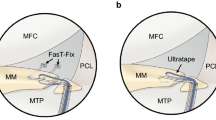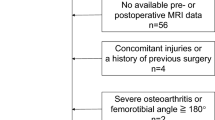Abstract
Purpose
Medial meniscus posterior root tears (MMPRTs) can cause severe medial extrusion of the medial meniscus (MMME) and the progression of knee degenerative changes, inducing a high signal intensity of the meniscus on magnetic resonance imaging (MRI). Although MMME and intrameniscal signal intensity (IMSI) reportedly decreased within 3 months after MMPRT repair, no previous studies have reported these changes after a 1-year follow-up. This study aimed to investigate the 1-year postoperative changes in MMME and IMSI on MRI after using different suture techniques.
Methods
Overall, 33 patients with MMPRT were evaluated, 22 underwent FasT-Fix-dependent modified Mason–Allen suture (F-MMA) repair, and 11 underwent two simple stitches (TSS) repair. MRI examinations were performed preoperatively and 1 year postoperatively. MMME and IMSI were determined using MRI.
Results
A significant decrease in postoperative MMME was observed in the TSS group (4.1 ± 1.0) relative to that in the F-MMA group (5.1 ± 1.4, P = 0.03). A significant decrease in postoperative IMSI (0.75 ± 0.14) was observed relative to preoperative IMSI in the TSS group (P < 0.01), whereas postoperative IMSI (0.94 ± 0.25) was similar to preoperative IMSI in the F-MMA group (P = 0.06). Furthermore, a significant decrease in postoperative IMSI was observed in the TSS group relative to that in the F-MMA group (P < 0.01).
Conclusions
The most important finding of this study is that TSS repair yielded a greater decrease in MMME and IMSI than F-MMA repair in patients with MMPRT. These results suggest that TSS repair is more useful for restoring loading stress to the posterior horn of the medial meniscus.





Similar content being viewed by others
Availability of data and material
Not applicable.
Code availability
Not applicable.
References
Marzo JM, Gurske-DePerio J (2009) Effects of medial meniscus posterior horn avulsion and repair on tibiofemoral contact area and peak contact pressure with clinical implications. Am J Sports Med 37(1):124–129. https://doi.org/10.1177/0363546508323254
Okazaki Y, Furumatsu T, Masuda S, Miyazawa S, Kodama Y, Kamatsuki Y, Hino T, Okazaki Y, Ozaki T (2018) Pullout repair of the medial meniscus posterior root tear reduces proton density-weighted imaging signal intensity of the medial meniscus. Acta Med Okayama 72(5):493–498. https://doi.org/10.18926/amo/56247
Hodler J, Haghighi P, Trudell D, Resnick D (1993) Degenerative changes of the menisci of the knee: value of different MR pulse sequences. Acta Radiol (Stockholm, Sweden: 1987) 34(4):404–407
Hiranaka T, Furumatsu T, Masuda S, Okazaki Y, Okazaki Y, Kodama Y, Kamatsuki Y, Kajiki Y, Zhang X, Ozaki T (2020) A repair technique using two simple stitches reduces the short-term postoperative medial meniscus extrusion after pullout repair for medial meniscus posterior root tear. Eur J Orthop Surg Traumatol Orthop Traumatol 30(5):901–908. https://doi.org/10.1007/s00590-020-02647-w
Chung KS, Ha JK, Ra HJ, Kim JG (2016) A meta-analysis of clinical and radiographic outcomes of posterior horn medial meniscus root repairs. Knee Surg Sports Traumatol Arthrosc Off J ESSKA 24(5):1455–1468. https://doi.org/10.1007/s00167-015-3832-0
Kim SB, Ha JK, Lee SW, Kim DW, Shim JC, Kim JG, Lee MY (2011) Medial meniscus root tear refixation: comparison of clinical, radiologic, and arthroscopic findings with medial meniscectomy. Arthrosc J Arthrosc Relat Surg Off Publ Arthrosc Assoc N Am Int Arthrosc Assoc 27(3):346–354. https://doi.org/10.1016/j.arthro.2010.08.005
Okazaki Y, Furumatsu T, Kamatsuki Y, Nishida K, Nasu Y, Nakahara R, Saito T, Ozaki T (2020) Differences between the root and horn cells of the human medial meniscus from the osteoarthritic knee in cellular characteristics and responses to mechanical stress. J Orthop Sci. https://doi.org/10.1016/j.jos.2020.02.015
Markolf KL, Jackson SR, McAllister DR (2012) Force measurements in the medial meniscus posterior horn attachment: effects of anterior cruciate ligament removal. Am J Sports Med 40(2):332–338. https://doi.org/10.1177/0363546511426100
McCauley TR (2005) MR imaging evaluation of the postoperative knee. Radiology 234(1):53–61. https://doi.org/10.1148/radiol.2341031302
Furumatsu T, Fujii M, Kodama Y, Ozaki T (2017) A giraffe neck sign of the medial meniscus: a characteristic finding of the medial meniscus posterior root tear on magnetic resonance imaging. J Orthop Sci Off J Jpn Orthop Assoc 22(4):731–736. https://doi.org/10.1016/j.jos.2017.03.013
Furumatsu T, Okazaki Y, Hiranaka T, Kodama Y, Kamatsuki Y, Okazaki Y, Zhang X, Ozaki T (2020) An MRI-based suspension bridge sign can predict an arthroscopically favorable meniscal healing following the medial meniscus posterior root repair. J Orthop Sci Off J Jpn Orthop Assoc. https://doi.org/10.1016/j.jos.2020.03.012
Fujii M, Furumatsu T, Kodama Y, Miyazawa S, Hino T, Kamatsuki Y, Yamada K, Ozaki T (2017) A novel suture technique using the FasT-Fix combined with Ultrabraid for pullout repair of the medial meniscus posterior root tear. Eur J Orthop Surg Traumatol Orthop Traumatol 27(4):559–562. https://doi.org/10.1007/s00590-017-1930-z
Okazaki Y, Furumatsu T, Kodama Y, Kamatsuki Y, Masuda S, Ozaki T (2019) Description of a surgical technique of medial meniscus root repair: a fixation technique with two simple stiches under an expected initial tension. Eur J Orthop Surg Traumatol Orthop Traumatol 29(3):705–709. https://doi.org/10.1007/s00590-018-2347-z
Okazaki Y, Furumatsu T, Miyazawa S, Masuda S, Okazaki Y, Hiranaka T, Ozaki T (2019) A novel suture technique to reduce the meniscus extrusion in the pullout repair for medial meniscus posterior root tears. Eur J Orthop Surg Traumatol Orthop Traumatol 29(8):1805–1809. https://doi.org/10.1007/s00590-019-02513-4
Okazaki Y, Furumatsu T, Okazaki Y, Masuda S, Hiranaka T, Kodama Y, Kamatsuki Y, Miyazawa S, Tetsunaga T, Ozaki T (2020) Medial meniscus posterior root repair decreases posteromedial extrusion of the medial meniscus during knee flexion. Knee 27(1):132–139. https://doi.org/10.1016/j.knee.2019.09.005
Furumatsu T, Kodama Y, Fujii M, Tanaka T, Hino T, Kamatsuki Y, Yamada K, Miyazawa S, Ozaki T (2017) A new aiming guide can create the tibial tunnel at favorable position in transtibial pullout repair for the medial meniscus posterior root tear. Orthop Traumatol Surg Res OTSR 103(3):367–371. https://doi.org/10.1016/j.otsr.2017.01.005
Fujii M, Furumatsu T, Miyazawa S, Kodama Y, Hino T, Kamatsuki Y, Ozaki T (2017) Bony landmark between the attachment of the medial meniscus posterior root and the posterior cruciate ligament: CT and MR imaging assessment. Skelet Radiol 46(8):1041–1045. https://doi.org/10.1007/s00256-017-2625-6
Fujii M, Furumatsu T, Miyazawa S, Okada Y, Tanaka T, Ozaki T, Abe N (2015) Intercondylar notch size influences cyclops formation after anterior cruciate ligament reconstruction. Knee Surg Sports Traumatol Arthrosc Off J ESSKA 23(4):1092–1099. https://doi.org/10.1007/s00167-014-2891-y
Kodama Y, Furumatsu T, Fujii M, Tanaka T, Miyazawa S, Ozaki T (2016) Pullout repair of a medial meniscus posterior root tear using a FasT-Fix((R)) all-inside suture technique. Orthop Traumatol Surg Res OTSR 102(7):951–954. https://doi.org/10.1016/j.otsr.2016.06.013
Furumatsu T, Miyazawa S, Fujii M, Tanaka T, Kodama Y, Ozaki T (2019) Arthroscopic scoring system of meniscal healing following medial meniscus posterior root repair. Int Orthop 43(5):1239–1245. https://doi.org/10.1007/s00264-018-4071-z
De Smet AA, Tuite MJ (2006) Use of the “two-slice-touch” rule for the MRI diagnosis of meniscal tears. AJR Am J Roentgenol 187(4):911–914. https://doi.org/10.2214/ajr.05.1354
Lee DH, Lee BS, Chung JW, Kim JM, Yang KS, Cha EJ, Bin SI (2011) Changes in magnetic resonance imaging signal intensity of transplanted meniscus allografts are not associated with clinical outcomes. Arthrosc J Arthrosc Relat Surg Off Publ Arthrosc Assoc N Am Int Arthrosc Assoc 27(9):1211–1218. https://doi.org/10.1016/j.arthro.2011.03.087
Kanda Y (2013) Investigation of the freely available easy-to-use software ‘EZR’ for medical statistics. Bone Marrow Transpl 48(3):452–458. https://doi.org/10.1038/bmt.2012.244
Han SB, Shetty GM, Lee DH, Chae DJ, Seo SS, Wang KH, Yoo SH, Nha KW (2010) Unfavorable results of partial meniscectomy for complete posterior medial meniscus root tear with early osteoarthritis: a 5- to 8-year follow-up study. Arthrosc J Arthrosc Relat Surg Off Publ Arthrosc Assoc N Am Int Arthrosc Assoc 26(10):1326–1332. https://doi.org/10.1016/j.arthro.2010.01.032
Krych AJ, Reardon PJ, Johnson NR, Mohan R, Peter L, Levy BA, Stuart MJ (2017) Non-operative management of medial meniscus posterior horn root tears is associated with worsening arthritis and poor clinical outcome at 5-year follow-up. Knee Surg Sports Traumatol Arthrosc Off J ESSKA 25(2):383–389. https://doi.org/10.1007/s00167-016-4359-8
Arnoczky SP, Cooper TG, Stadelmaier DM, Hannafin JA (1994) Magnetic resonance signals in healing menisci: an experimental study in dogs. Arthrosc J Arthrosc Relat Surg Off Publ Arthrosc Assoc N Am Int Arthrosc Assoc 10(5):552–557. https://doi.org/10.1016/s0749-8063(05)80013-1
Deutsch AL, Mink JH, Fox JM, Arnoczky SP, Rothman BJ, Stoller DW, Cannon WD Jr (1990) Peripheral meniscal tears: MR findings after conservative treatment or arthroscopic repair. Radiology 176(2):485–488. https://doi.org/10.1148/radiology.176.2.2367665
Li CA, Kim MK, Kim IH, Lee JH, Jang KY, Lee SY (2013) Correlation of histological examination of meniscus with MR images: focused on high signal intensity of the meniscus not caused by definite meniscal tear and impact on mr diagnosis of tears. Korean J Radiol 14(6):935–945. https://doi.org/10.3348/kjr.2013.14.6.935
Hodler J, Haghighi P, Pathria MN, Trudell D, Resnick D (1992) Meniscal changes in the elderly: correlation of MR imaging and histologic findings. Radiology 184(1):221–225. https://doi.org/10.1148/radiology.184.1.1609084
Kursunoglu-Brahme S, Schwaighofer B, Gundry C, Ho C, Resnick D (1990) Jogging causes acute changes in the knee joint: an MR study in normal volunteers. AJR Am J Roentgenol 154(6):1233–1235. https://doi.org/10.2214/ajr.154.6.2110734
Anz AW, Branch EA, Saliman JD (2014) Biomechanical comparison of arthroscopic repair constructs for meniscal root tears. Am J Sports Med 42(11):2699–2706. https://doi.org/10.1177/0363546514549445
Krych AJ, Johnson NR, Wu IT, Smith PA, Stuart MJ (2018) A simple cinch is superior to a locking loop for meniscus root repair: a human biomechanical comparison of suture constructs in a transtibial pull-out model. Knee Surg Sports Traumatol Arthrosc Off J ESSKA 26(8):2239–2244. https://doi.org/10.1007/s00167-017-4652-1
Acknowledgements
We would like to thank Editage (www.editage.com) for English language editing.
Funding
This research did not receive any specific grant from funding agencies in the public, commercial, or not-for-profit sectors.
Author information
Authors and Affiliations
Contributions
Takayuki Furumatsu designed the study. Yuki Okazaki and Takaaki Hiranaka contributed to the analysis and interpretation of data. All authors contributed to data collection and interpretation and critically reviewed the manuscript. All authors approved the final version of the manuscript and agreed to be accountable for all aspects of the work in ensuring that questions related to the accuracy or integrity of any part of the work are appropriately investigated and resolved.
Corresponding author
Ethics declarations
Conflict of interest
The authors declare that they have no conflict of interest.
Ethical approval
This study, and all protocols, was approved by our Institutional Ethics Review Board.
Consent to participate
All patients provided informed consent to participate in this study.
Consent for publication
All participants provided informed consent for the publication of this study.
Additional information
Publisher's Note
Springer Nature remains neutral with regard to jurisdictional claims in published maps and institutional affiliations.
Rights and permissions
About this article
Cite this article
Okazaki, Y., Furumatsu, T., Hiranaka, T. et al. Two simple stitches for medial meniscus posterior root repair prevents the progression of meniscal extrusion and reduces intrameniscal signal intensity better than modified Mason-Allen sutures. Eur J Orthop Surg Traumatol 31, 1005–1013 (2021). https://doi.org/10.1007/s00590-020-02830-z
Received:
Accepted:
Published:
Issue Date:
DOI: https://doi.org/10.1007/s00590-020-02830-z




